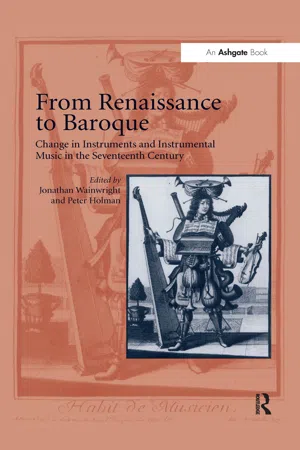
From Renaissance to Baroque
Change in Instruments and Instrumental Music in the Seventeenth Century
- 340 pages
- English
- ePUB (mobile friendly)
- Available on iOS & Android
From Renaissance to Baroque
Change in Instruments and Instrumental Music in the Seventeenth Century
About this book
Historians of instruments and instrumental music have long recognised that there was a period of profound change in the seventeenth century, when the consorts or families of instruments developed during the Renaissance were replaced by the new models of the Baroque period. Yet the process is still poorly understood, in part because each instrument has traditionally been considered in isolation, and changes in design have rarely been related to changes in the way instruments were used, or what they played. The essays in this book are by distinguished international authors that include specialists in particular instruments together with those interested in such topics as the early history of the orchestra, iconography, pitch and continuo practice. The book will appeal to instrument makers and academics who have an interest in achieving a better understanding of the process of change in the seventeenth century, but the book also raises questions that any historically aware performer ought to be asking about the performance of Baroque music. What sorts of instruments should be used? At what pitch? In which temperament? In what numbers and/or combinations? For this reason, the book will be invaluable to performers, academics, instrument makers and anyone interested in the fascinating period of change from the 'Renaissance' to the 'Baroque'.
Frequently asked questions
- Essential is ideal for learners and professionals who enjoy exploring a wide range of subjects. Access the Essential Library with 800,000+ trusted titles and best-sellers across business, personal growth, and the humanities. Includes unlimited reading time and Standard Read Aloud voice.
- Complete: Perfect for advanced learners and researchers needing full, unrestricted access. Unlock 1.4M+ books across hundreds of subjects, including academic and specialized titles. The Complete Plan also includes advanced features like Premium Read Aloud and Research Assistant.
Please note we cannot support devices running on iOS 13 and Android 7 or earlier. Learn more about using the app.
Information
Chapter One
Baptiste’s Hautbois: The Metamorphosis from Shawm to Hautboy in France, 1620–1670
Introduction
Experiments with the Pirouette and Reed
The Protomorphic Hautboy
| Il faut remarquer qu’il y a deux sortes de Haut-b... |
Table of contents
- Cover
- Title Page
- Copyright Page
- Contents
- Preface
- Acknowledgements
- List of Illustrations
- List of Tables and Figure
- List of Musical Examples
- Notes on the Contributors
- Introduction: From ‘Renaissance’ to ‘Baroque’?
- 1 Baptiste’s Hautbois: The Metamorphosis from Shawm to Hautboy in France, 1620–1670
- 2 A Commentary on the Letter by Michel de La Barre Concerning the History of Musettes and Hautboys
- 3 The Woodwind Instruments of Richard Haka (1645/6–1705)
- 4 Basstals or Curtoons: The Search for a Transitional Fagott
- 5 The Iconographic Background to the Seventeenth-Century Recorder
- 6 The Renaissance Flute in the Seventeenth Century
- 7 The Flute at Dresden: Ramifications for Eighteenth-Century Woodwind Performance in Germany
- 8 How did Seventeenth-Century English Violins Really Sound?
- 9 The Development of French Lute Style 1600–1650
- 10 The Early Air de Cour, the Theorbo, and the Continuo Principle in France
- 11 From Stops Organical to Stops of Variety: The English Organ from 1630 to 1730
- 12 Upgrading from Consorts to Orchestra at the Württemberg Court
- 13 From Violin Band to Orchestra
- 14 Organological Gruyère
- Workshop Report
- Bibliography
- Index